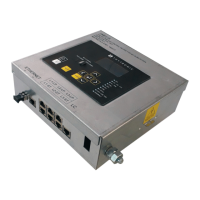23
SME2-IS - Manual - 06- 2021
FUNCTIONAL CHARACTERISTICS
4.2 SOFTWARE
Basic software
The software is composed of basic modules which are independent of the specific application. It has
a modular structure which enables it to adapt automatically to a variety of applications.
Real-time operating system
The devices runs the PETALINUX OS, which is based on YOCTO PROJECT.
The real time OS has a preemptive multithreading architecture which can handle multiple subpro-
cesses.
The kernel is the core of the system and includes the processing functions closest to the electronic
circuits.
The software has a task-based structure with interrupts acting at various priorities.
Processes (task)
The tasks (processes and threads) are the basic components of the system.
Tasks include:
• Button handling
• RTC (Real Time Clock) updates
• RAM/EEPROM updates
• Process diagnostics
• Input reads
• Output relay commands
• MMI handling
• Peripheral handling
• Measurement processing.
Drivers
The driver library contains all the specialised modules required by the command and control func-
tions which connect the kernel to the application itself. The drivers include:
• Database management
• PC message handling
• Counter handling
• Event handling
• Measurement handling
• Disturbance recording function handling.
The application software
The application software is a specialisation of the system based on the modules of the basic soft-
ware; it contains all the elements required to implement the protection and control functions.
The fundamental modules are:
• Application level diagnostics
• Input handling (logical inputs)
• Protection Functions
• Event recording
• Output handling.
Each element (kernel, drivers and application) can itself be divided into modules:
Basic protocol (kernel)
The driver handles communications via a dedicated channel with the following services:
• Exchange of data and information
• Calibration
• Firmware upgrade.
Communications (drivers)
The protection communicates with the Thyvisor conguration software with the MODBUS RTU
protocol.
All principle codes given in the standard are implemented; for a full description and the map of
addresses, refer to the remote programming manual.
MMI (drivers)
This handles the menus, both on the panel and via messages, which are displayed with commands
using the keypad, LEDs and the LCD display.
Data Base
The database has a three-section modular structure:
• RAM containing volatile data
• REE and PAR containing data recorded to non-volatile memory.
Self test (application)
This function cyclically monitors the operation of the main hardware and software functions without
signicantly slowing down the processing cycle.

